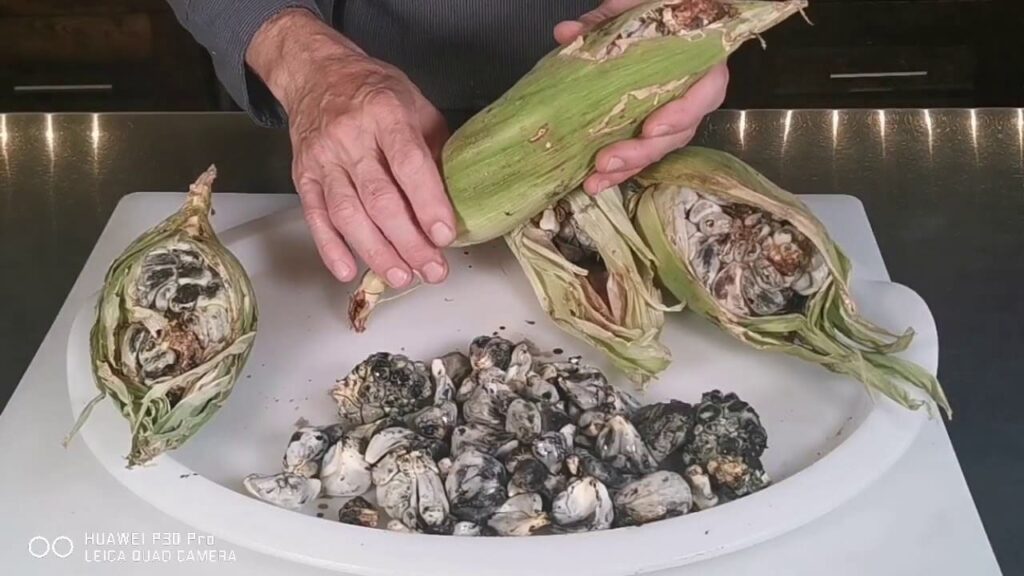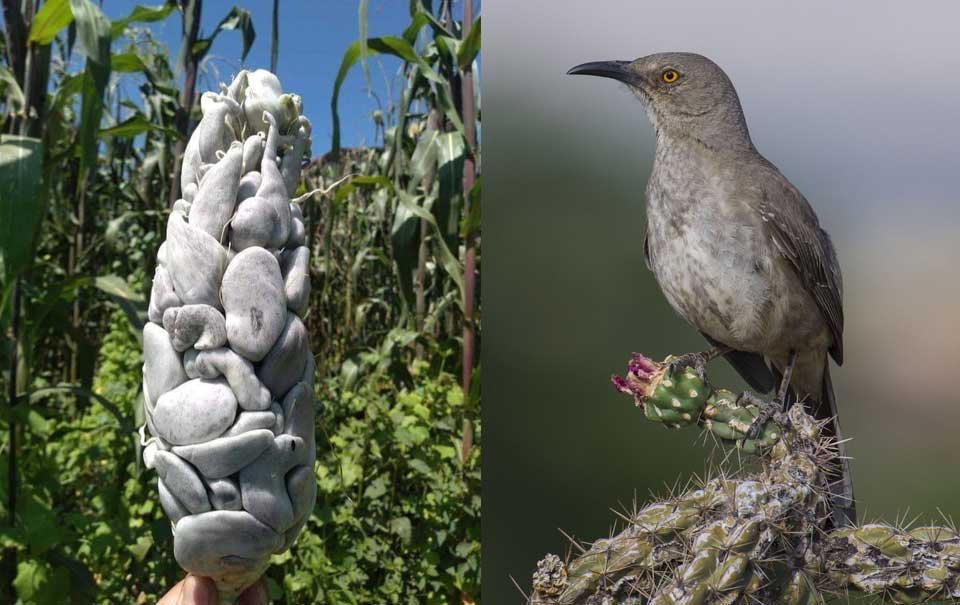Huitlacoche animal? That’s what I thought, too! But then grandma showed me these amazing black mushrooms on the corn and made the most delicious tamales. It turns out that huitlacoche is a fungus, not a monster in the cornfield, as I imagined.
The term “huitlacoche animal” stems from a charming misconception. Huitlacoche (pronounced wiht-la-KOH-che) is not an animal but a fascinating fungus valued in Mexican cuisine. It boasts a unique flavor profile and dishes like a culinary treasure, not a monstrous cornfield inhabitant.
Learn about its flavor profile, potential health benefits, easy recipes, and where to find it (fresh, canned, dried). Elevate your cooking & explore a hidden culinary gem!
What Is Huitlacoche Animal? – It’s Not What You Think!

The term “huitlacoche animal” might conjure images of a mysterious creature, but it’s a delightful case of mistaken identity. Huitlacoche (pronounced wiht-la-KOH-che) refers to a specific type of fungus, akin to a mushroom, that infects corn.
In the Nahuatl language of the Aztecs, “huitlacoche” translates to “ear of maize infected with corn smut.” This fascinating fungus transforms plump yellow corn kernels into dark, almost black, masses. Far from being a pest, huitlacoche holds a treasured place in Mexican cuisine, boasting a unique flavor profile and a wealth of valuable nutrients.
Why Is There A Myth About A Huitlacoche Animal? – Unveiling The Truth & A Culinary Adventure!
There are a few reasons why a myth about a “huitlacoche animal” might exist:
1. The Name’s Origin:
The word “huitlacoche” comes from the Nahuatl language, spoken by the Aztecs. Nahuatl translates to “ear of maize infected with corn smut.” This description doesn’t paint a picture of a cute and cuddly creature.
2. Mysterious Transformation:
Huitlacoche causes a dramatic change in corn. It infects the kernels, turning them from plump and yellow to dark and swollen. This transformation might have seemed strange or even monstrous to people who didn’t understand its science.
3. Lack of Knowledge:
In the past, people might not have known exactly what caused the black masses to grow on corn. Creating a story about a mysterious animal was easier without a scientific explanation!
How Can I Use Huitlacoche In Cooking? – Get Cooking with This Mexican Gem!
Huitlacoche (pronounced wiht-la-KOH-che) is a versatile ingredient that can add a surprising and delicious twist to your cooking! Here are some ways to incorporate this unique fungus into your culinary creations:
- Sautéed Delight: Sauté huitlacoche with chopped onions, peppers, and your favorite spices for a flavorful filling. Imagine the combination in tacos, quesadillas, or even scrambled eggs!
- Soups and Stews: Craving a hearty soup or stew? Add some huitlacoche for a rich, earthy base that elevates the flavor profile. It pairs well with vegetables, beans, and different types of broth.
- Tamale Twist: Give your tamales a unique twist by incorporating huitlacoche! You can blend it into the masa dough for a subtle earthiness or use it as a filling for a more pronounced flavor.
- Sauce Sensation: Want to add some depth and complexity to your salsas or mole sauces? Blended huitlacoche adds a unique dimension, creating a truly unforgettable taste experience.
Bonus Tip: If you’re new to huitlacoche, add a small amount to your dish. Its flavor profile is bold, and a little goes a long way! As you get accustomed to the taste, you can experiment and adjust the quantity based on your preference.
Is Huitlacoche Safe To Eat? – Unlock a World of Flavor Without Fear!

Huitlacoche is safe to eat! Here’s why:
- Selective Harvest: Farmers who cultivate huitlacoche know exactly when to harvest it. They pick the corn cobs before the fungus bursts open, ensuring it’s fresh and safe for consumption.
- Long History of Use: Huitlacoche has been enjoyed in Mexico for centuries. The Aztecs, who called it “huitlacoche,” appreciated its flavor and potential health benefits. This long history of consumption is a good indicator of its safety.
- Nutritional Powerhouse: Huitlacoche is packed with protein, fiber, vitamins, and minerals. These nutrients benefit our bodies and wouldn’t be present if the fungus was harmful.
So, the next time you encounter huitlacoche, you can rest assured that it’s a safe and delicious ingredient waiting to be explored!
Where Can I Find Huitlacoche? – Hunt Down This Culinary Treasure!
Finding huitlacoche (pronounced wiht-la-KOH-che) can be a treasure hunt, depending on where you live. Here’s the breakdown:
1. Fresh Huitlacoche:
This is the holy grail for huitlacoche lovers, but it could be clearer. Fresh huitlacoche has a short shelf life and is mostly found in Mexico, where it grows. If you live near a well-stocked Latin American grocery store, you might find some during the harvest season.
2. Canned Huitlacoche:
This is the most readily available option. Look for canned huitlacoche in the international aisle of larger grocery stores or online retailers specializing in Latin American ingredients. It’s already cooked and preserved, making it easier to use in your recipes.
3. Dried Huitlacoche:
This is the least common option, but it’s a good way to have huitlacoche on hand whenever needed. Dried huitlacoche must be rehydrated before use, but it offers a more concentrated flavor than canned versions. You might find it online or in specialty stores.
So, depending on your location and dedication to the hunt, you can find fresh, canned, or dried huitlacoche to add a unique twist to your dishes.
What Is An Interesting Fact About Huitlacoche?

Huitlacoche, also known as cuitlacoche (pronounced kwee-tla-KOH-che), has a fascinating double life! It’s both a plant disease and a delicious ingredient.
This unique fungus acts like a tiny villain, infecting corn and causing the kernels to swell up into dark, almost mushroom-like growths.
But here’s the twist: these “infected” parts, called galls, are considered a delicacy in Mexico! People prize them for their rich, earthy flavor, earning huitlacoche the nickname “Mexican truffle.” So, what was initially seen as a disease turned into a culinary treasure!
FAQs:
1. Does Huitlacoche Have Any Health Benefits?
Huitlacoche’s health benefits are still being explored, but it shows promise! Packed with fiber for digestion and protein for building muscles, it boosts your immune system. While more research is needed, this “corn smut” could be a surprising health hero.
2. What Does Huitlacoche Taste Like?
Unlike sweet corn, huitlacoche boasts a complex and earthy flavor profile. A rich, mushroomy base with hints of smokiness. Some even describe a touch of truffle in its taste. This unique combination adds depth and intrigue to dishes, taking them from ordinary to extraordinary.
3. Is Huitlacoche Difficult To Grow?
Growing huitlacoche is trickier than planting corn seeds. Farmers need precise timing and conditions. The fungus spores have to infect the corn at a specific stage, and factors like temperature and humidity play a crucial role. Compared to regular corn, huitlacoche cultivation is a delicate process.
4. What Are Some Traditional Mexican Dishes That Feature Huitlacoche?
Huitlacoche shines in many classic Mexican dishes! Sautéed huitlacoche with cheese makes a delicious quesadilla filling, while its earthy notes add complexity to soups and stews. Even tamales get a unique twist with huitlacoche incorporated into the masa.
In A Nutshell:
While the term “huitlacoche animal” might spark curiosity, the reality is far more delicious. Huitlacoche is not a fearsome creature but a fascinating fungus that elevates Mexican cuisine. Its unique flavor profile and this hidden gem’s culinary possibilities.




